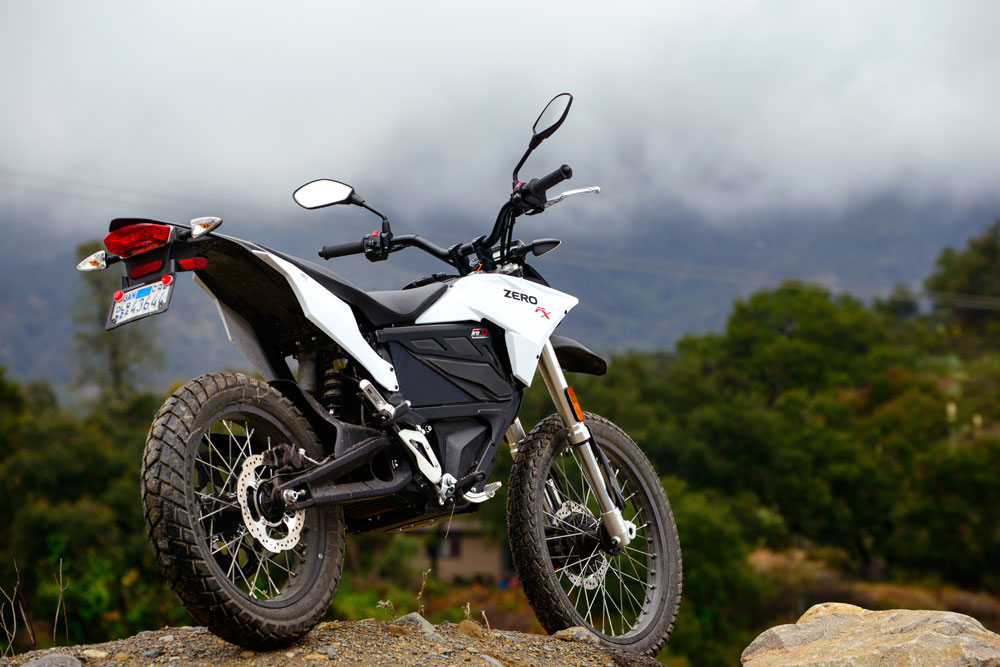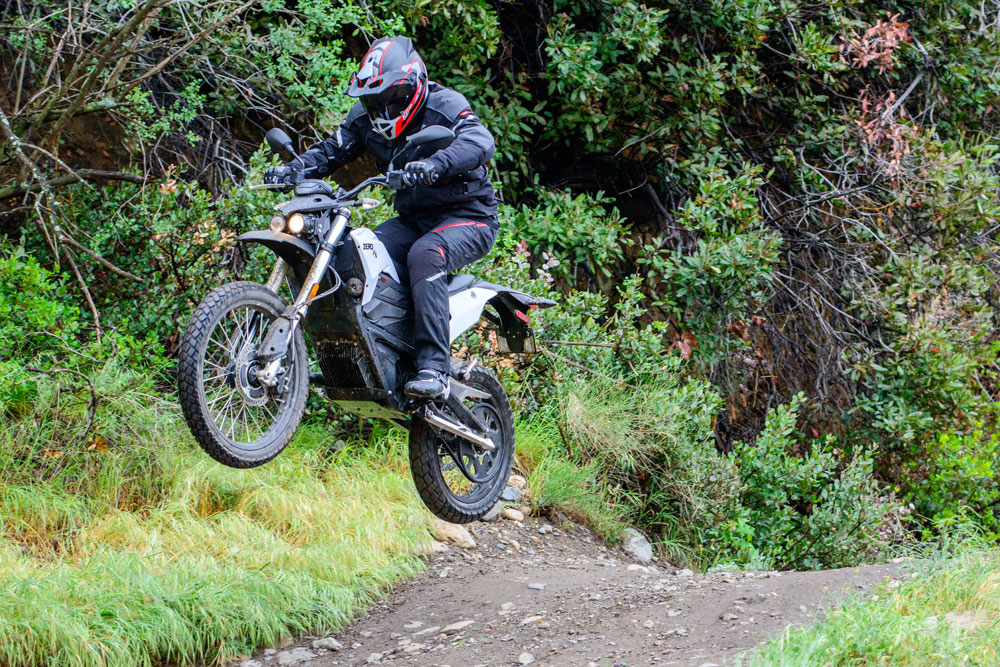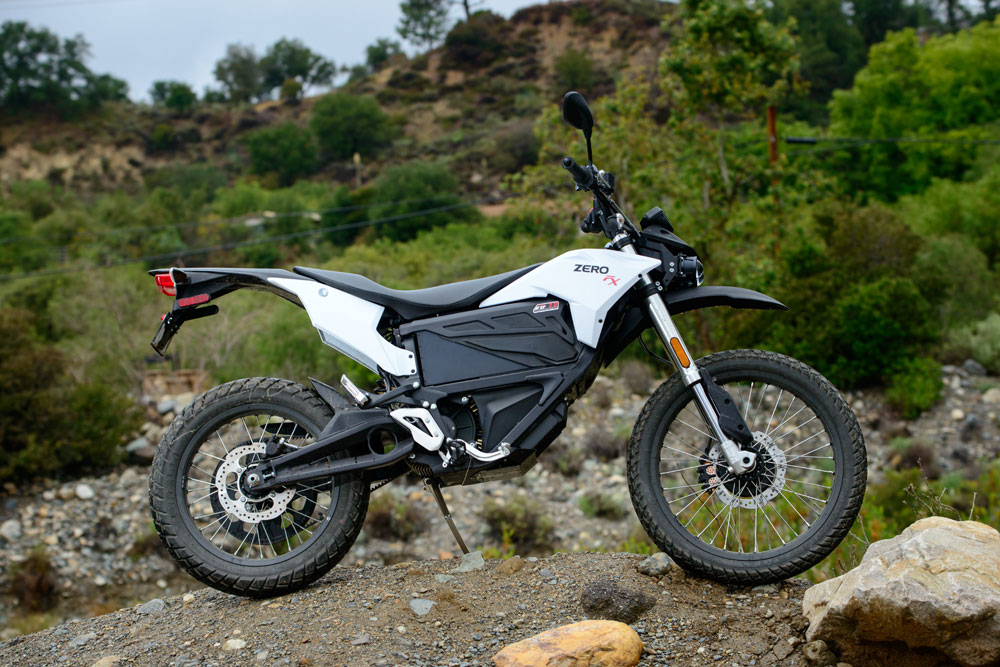Rennie Scaysbrook | June 15, 2018
Zero By Name—This is the Zero FX. Let’s go for a ride.
You know those times when you get something new, you’re pumped, you experience it, but you go away feeling like you’ve been punched in the gut?
 Zero markets this FX as a dual sport. It looks the part. Sort of.
Zero markets this FX as a dual sport. It looks the part. Sort of.
I didn’t get that feeling with the 2018 Zero FX. Because I didn’t buy one. But if I had, that’s how I would feel. Not a great way to start a bike review, huh?
There are very few redeeming qualities about the Zero FX. I have ridden and enjoyed some of Zero’s products in the past, but I struggle to come up with something nice to say about the FX.

Photography by Kit Palmer
The reason being is it does nothing well and what it doesn’t do awfully, it does mediocre.
It handles like an overgrown mountain bike on dirt trails, has an aesthetic derived from some alternate moto universe, and the best range I could get out of it was 41 miles in Eco mode from a full charge that took some nine hours to attain.
Electric bikes are not cool. They never have been, and for lots of riders, never will be (some other electric companies are trying to change this, namely Alta and lately Curtiss Motorcycles). It’s a shame this is the case because riding an electric bike can be good fun, but I think many riders will never allow themselves the opportunity to experience them.
 There’s plenty of ground clearance, so you can hit trails (and water), so long as you have the charge to get there.
There’s plenty of ground clearance, so you can hit trails (and water), so long as you have the charge to get there.
I’m not going to wax on about the serene experience of a silent ride, about how you’re saving the polar bears or how you’re putting cash back in your pocket by buying an FX—or any other ‘lectric bike for that matter—I’m just going to break it down into the good and bad of riding this Zero FX dual-sport machine.
First, the good.
On a full charge from the ZF7.2 battery (7.2 kWh), this Zero is really good fun to experience. The FX is fast, especially when it’s logged into Sport mode and considering it’s pushing only 289 pounds, and you’ll never get tired of leaving pretty much anything for dead at the traffic lights. There’s a claimed 46 horsepower and 78 lb-ft of torque on offer, and its delivery is immediate in the truest sense of the word.
 The FX’s front brake disc is the same size as the rear with one more piston. Say what?
The FX’s front brake disc is the same size as the rear with one more piston. Say what?
Throttle response has improved over the years, but it’s still one of the bike’s weak points. Riding the FX off-road and on trails strewn with rocks is an exercise in patience, making sure you’re ready for that big rush of torque. It sounds ridiculous but the fitment of some kind of electric clutch wouldn’t be a bad idea, as you could meter low-speed torque in a much finer way than just leaving it up to your right hand.
Riding the bike to and from the shops is where it shines. Several times I’d jump on this thing to sprint down to the grocery story and grab some diapers or milk or beer and jet home. Those quick trips are ideally suited to the Zero FX.
Zero has its own app that can change everything from custom top speed to max torque, max regen braking, and it’s all quite easy and fun to use as you scroll through the various features. The differences have a marked effect on how the Zero rides, and is one of best features of having an electric bike in the first place.
 This must be one of the ugliest faces ever seen on a motorcycle.
This must be one of the ugliest faces ever seen on a motorcycle.
Now, the bad.
For a dual-sport bike, it handles terribly. The weight is too high up, although the bike isn’t as top-heavy as something like the road-going Zero DS.
Quick direction changes are not too bad, but the overall ride quality leaves a lot to be desired. Smooth, easy flowing tarmac roads are okay on the FX, I think primarily due to the big 21-inch front and 18-inch rear wheels. The ride quality on tarmac is mediocre, but the suspension performance off-road is not up to the price tag.
On dirt, on standard settings, the fork will bottom easily and the shock is so harsh it feels like it’s going to punch up through the seat.
There’s a claimed 8.6 inches of fork and 8.94 inches of shock travel, and let me assure you, you’ll use every one of them if you take the bike off-road. The fork and shock are both fully adjustable, so at least that’s something.
The front brakes are nothing short of rubbish. Graced with a J-Juan twin-piston front caliper mitigated by a Bosch Gen 9 ABS system, the FX will stop quickly if you’re doing 20 mph. Any more than that requires lots of forethought. A couple of times on dirt the ABS would kick in so quickly there’d hardly be any speed retardation happening as the lever pulsed like a dying fish. You can turn the ABS off, but I can imagine many riders not experienced in dirt riding will want the safety net of ABS. Turning it off is a pain, anyway. Topping the brake package off, the master cylinder is ancient with next to no feel at the lever when you’re moving quickly.
 Belt drive is good for silence on the road but fragile on the trail.
Belt drive is good for silence on the road but fragile on the trail.
Zero claims a top speed of 85 mph for its FX with the ZF7.2 battery with a top sustained speed of 70 mph. But when on that speed for any length of time, I could see the remaining range drop like some electricity tank that had a hole in the bottom of it, even in Eco mode.
This brings me to my biggest gripe with the FX—the range. Zero claims in city riding, the FX is good for 91 miles from full charge to empty. On a highway at 55 mph, they say you’ll get 56 miles. Combined city and a bit of highway riding should yield 69 miles. Now, change that to 70 mph of highway riding, you’ll get just 39 miles. Mix in some city riding, you should see 54 miles out of a charge. It’s all rather confusing.
I put this to the test by charging the battery to 100 percent and riding it until it I had just enough juice to get me home. To give the FX an added chance, I rode in Eco mode and rode sensibly, with only one time where I hit 70 mph between the traffic lights. The riding consisted of my cycling loop around my house, with a 15-mile stretch of traffic light-free riding at 55 mph, followed by 18 sets of traffic lights on the way home, so more city than highway style.
 Dash holds info like range and speed, but most of the adjustment is done through the app.
Dash holds info like range and speed, but most of the adjustment is done through the app.
I expected to see north of 60 miles of range. All I got out of the FX was 41.8 miles with five-percent charge left, and as I did not have the power-charger accessory, the FX was off the road for the next nine hours.
This just simply isn’t good enough for a bike that has a base price of $10,495. Grab the optional quick charger and you can kiss another $600 goodbye.
Zero needs to rethink this bike. As far as I’m concerned, the FX has zero real-world practicality unless you live in a city that requires no more than 20 miles of riding in each direction, and somewhere to charge up for a few hours at each end. Or if you live right on the trail you want to ride because chances are you’ll use more than half the available juice just getting to the trail in the first place.
 Any more hang time than this and we predict you’ll almost certainly snap the drive belt.
Any more hang time than this and we predict you’ll almost certainly snap the drive belt.
Zero has good products and should be commended for pushing the EV motorcycle space, but the FX is gimmicky, and I, after living with one for a short while, struggle to imagine why you’d want to buy one. CN

| SPECIFICATIONS |
2018 Zero FX ($10,495) |
| Engine: |
Z-Force 75-5 passively air-cooled, high efficiency, radial flux, interior permanent magnet, brushless motor |
| Chassis: |
Steel trellis |
| Front suspension: |
Showa 41mm conventional fork, fully adjustable |
| Rear suspension: |
Showa Monoshock, fully adjustable |
| Front brake: |
240mm disc, dual-piston caliper, ABS |
| Rear brake: |
240mm disc, single-piston caliper, ABS |
| Front tire: |
Pirelli Scorpion MT 90 A/T 90/90-21 |
| Rear tire: |
Pirelli Scorpion MT 90 A/T 120/80-18 |
| Wheelbase: |
56.6 in. |
| Seat height: |
34.7 in. |
| Weight: |
289 lbs. (ABS curb, claimed) |
| Color: |
Black, white |